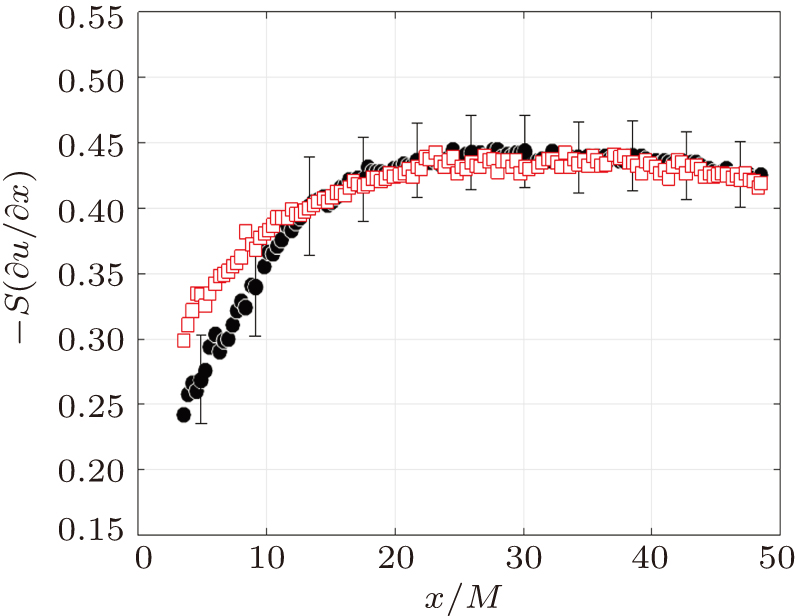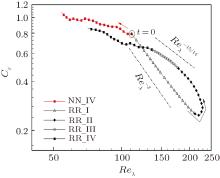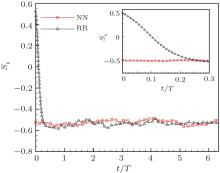中国物理B ›› 2020, Vol. 29 ›› Issue (11): 114702-.doi: 10.1088/1674-1056/abbbdc
Feng Liu(刘锋)1,2,†( ), Le Fang(方乐)2, Liang Shao(邵亮)3
), Le Fang(方乐)2, Liang Shao(邵亮)3
-
收稿日期:2020-08-10修回日期:2020-09-20接受日期:2020-09-28出版日期:2020-11-05发布日期:2020-11-03
The role of velocity derivative skewness in understanding non-equilibrium turbulence
Feng Liu(刘锋)1,2, †, Le Fang(方乐)2, and Liang Shao(邵亮)3$
- 1 School of Energy and Power Engineering, North University of China, Taiyuan 030051, China
2 Laboratory of Mathematics and Physics, Ecole Centrale de Pékin, Beihang University, Beijing 100191, China
3 Laboratoire de Mécaniques des Fluides et d’Acoustique, Ecole Centrale de Lyon–Université de Lyon, Ecully 69134, France
-
Received:2020-08-10Revised:2020-09-20Accepted:2020-09-28Online:2020-11-05Published:2020-11-03 -
Contact:†Corresponding author. E-mail:feng.liu@nuc.edu.cn -
Supported by:the National Natural Science Foundation of China (Grant No. 11772032) and the Science Foundation of North University of China (Grant No. 11026829).
引用本文
Feng Liu(刘锋), Le Fang(方乐), Liang Shao(邵亮). [J]. 中国物理B, 2020, 29(11): 114702-.
Feng Liu(刘锋), Le Fang(方乐), and Liang Shao(邵亮)$. The role of velocity derivative skewness in understanding non-equilibrium turbulence[J]. Chin. Phys. B, 2020, 29(11): 114702-.
| [1] |
Vassilicos J C 2015 Ann. Rev. Fluid Mech. 47 95 DOI: 10.1146/annurev-fluid-010814-014637
|
| [2] |
Castro I P 2016 J. Fluid Mech. 788 1 DOI: 10.1017/jfm.2015.630
|
| [3] |
Fang L Zhao H K Lu L P Liu Y W Yan H 2017 Aerosp. Sci. Technol. 71 78 DOI: 10.1016/j.ast.2017.09.020
|
| [4] |
Hearst R J Lavoie P 2015 Phys. Fluids 27 071701 DOI: 10.1063/1.4926356
|
| [5] |
Isaza J C Salazar R Warhaft Z 2014 J. Fluid Mech. 753 402 DOI: 10.1017/jfm.2014.375
|
| [6] |
Fang L Zhu Y Liu Y W Lu L P 2015 Phys. Lett. A 379 2331 DOI: 10.1016/j.physleta.2015.05.029
|
| [7] |
Ishihara T Kaneda Y Yokokawa M Itakura K Uno A 2007 J. Fluid Mech. 592 335 DOI: 10.1017/S0022112007008531
|
| [8] |
Wang L P Chen S Y Brasseur J G Wyngaard J C 1996 J. Fluid Mech. 309 113 DOI: 10.1017/S0022112096001589
|
| [9] |
Sreenivasan K R Antonia R A 1997 Ann. Rev. Fluid Mech. 29 435 DOI: 10.1146/annurev.fluid.29.1.435
|
| [10] |
Gotoh T Fukayama D Nakano T 2002 Phys. Fluids 14 1065 DOI: 10.1063/1.1448296
|
| [11] |
Hill R J 2002 J. Fluid Mech. 452 361 DOI: 10.1017/S0022112001007091
|
| [12] |
Gylfason A Ayyalasomayajula S Warhaft Z 2004 J. Fluid Mech. 501 213 DOI: 10.1017/S002211200300747X
|
| [13] |
Burattini P Lavoie P Antonia R A 2008 Exp. Fluids 45 523 DOI: 10.1007/s00348-008-0495-3
|
| [14] |
Tabeling P Zocchi G Belin F Maurer J Willaime H 1996 Phys. Rev. E 53 1613 DOI: 10.1103/PhysRevE.53.1613
|
| [15] |
Belin F Maurer J Tabeling P Willaime H 1997 Phys. Fluids 9 3843 DOI: 10.1063/1.869484
|
| [16] |
Atta C W V Antonia R A 1980 Phys. Fluids 23 252 DOI: 10.1063/1.862965
|
| [17] |
Liu F Lu L P Fang L 2018 J. Turbul. 19 731 DOI: 10.1080/14685248.2018.1511906
|
| [18] |
Thiesset F Antonia R A Djenidi L 2014 J. Fluid Mech. 748 R2 DOI: 10.1017/jfm.2014.235
|
| [19] |
Tang S L Antonia R A Djenidi L Zhou Y 2015 J. Fluid Mech. 784 109 DOI: 10.1017/jfm.2015.597
|
| [20] |
Lavoie P Djenidi L Antonia R A 2007 J. Fluid Mech. 585 395 DOI: 10.1017/S0022112007006763
|
| [21] |
Lee S K Djenidi L Antonia R A Danaila L 2013 Int. J. Heat Fluid Flow 43 129 DOI: 10.1016/j.ijheatfluidflow.2013.03.009
|
| [22] |
Tatsumi T Kida S Mizushima J 1978 J. Fluid Mech. 85 97 DOI: 10.1017/S0022112078000555
|
| [23] |
Antonia R A Tang S L Djenidi L Danaila L 2015 J. Fluid Mech. 781 727 DOI: 10.1017/jfm.2015.539
|
| [24] |
Djenidi L Antonia R A Talluru M K Abe H 2017 Phys. Fluids 2 064608
|
| [25] |
Mills R R Corrsin S 1959 NASA-MEMO 19980228031
|
| [26] |
Sjogren T Johansson A V 1998 J. Fluid Mech. 374 59 DOI: 10.1017/S0022112098002511
|
| [27] |
Ayyalasomayajula S Warhaft Z 2006 J. Fluid Mech. 566 273 DOI: 10.1017/S0022112006002199
|
| [28] |
Bos W J T Chevillard L Scott J Rubinstein R 2012 Phys. Fluids 24 015108 DOI: 10.1063/1.3678338
|
| [29] |
Tavoularis S Bennett J C Corrsin S 1978 J. Fluid Mech. 88 63 DOI: 10.1017/S0022112078001986
|
| [30] |
Qian J 1994 Acta Mech. Sin. 10 12 in Chinese DOI: 10.1007/BF02487653
|
| [31] |
Nelkin M 1990 Phys. Rev. A 42 7226 DOI: 10.1103/PhysRevA.42.7226
|
| [32] |
Goto S Vassilicos J C 2016 Phys. Rev. E 94 053108 DOI: 10.1103/PhysRevE.94.053108
|
| [33] |
Meldi M Sagaut P 2018 J. Turbul. 19 390 DOI: 10.1080/14685248.2018.1450506
|
| [34] |
Takamure K Sakai Y Ito Y Iwano K Hayase T 2019 Int. J. Heat Fluid Flow 75 77 DOI: 10.1016/j.ijheatfluidflow.2018.11.012
|
| [35] |
Liu F Lu L P Bos W J T Fang L 2019 Phys. Rev. Fluids 4 084603 DOI: 10.1103/PhysRevFluids.4.084603
|
| [36] |
Deissler R G 1978 Appl. Sci. Res. 34 379 DOI: 10.1007/BF00383972
|
| [37] |
Kolmogorov A N 1941 Dokl. Akad. Nauk. SSSR 32 16
|
| [38] |
Batchelor G K 1953 The theory of homogeneous turbulence Cambridge Cambridge University Press
|
| [39] |
Waleffe F 1992 Phys. Fluids A 4 350 DOI: 10.1063/1.858309
|
| [40] |
Yakhot V Orszag S A 1986 J. Sci. Comput. 1 3 DOI: 10.1007/BF01061452
|
| [41] |
Domaradzki J A Rogallo R S 1990 Phys. Fluids A 2 413 DOI: 10.1063/1.857736
|
| [42] |
Valente P C Onishi R da Silva C B 2014 Phys. Rev. E 90 023003 DOI: 10.1103/PhysRevE.90.023003
|
| [43] |
Goto S Vassilicos J C 2015 Phys. Lett. A 379 1144 DOI: 10.1016/j.physleta.2015.02.025
|
| [44] |
Seoud R E Vassilicos J C 2007 Phys. Fluids 19 105108 DOI: 10.1063/1.2795211
|
| [45] |
Valente P C Vassilicos J C 2014 J. Fluid Mech. 744 5 DOI: 10.1017/jfm.2014.41
|
| [46] |
Valente P C Vassilicos J C 2012 Phys. Rev. Lett. 108 214503 DOI: 10.1103/PhysRevLett.108.214503
|
| [47] |
Mazellier N Vassilicos J C 2008 Phys. Fluids 20 015101 DOI: 10.1063/1.2832778
|
| [48] |
Nedic J Vassilicos J C Ganapathisubramani B 2013 Phys. Rev. Lett. 111 144503 DOI: 10.1103/PhysRevLett.111.144503
|
| [49] |
Dairay T Obligado M Vassilicos J C 2015 J. Fluid Mech. 781 166 DOI: 10.1017/jfm.2015.493
|
| [50] |
Obligado M Dairay T Vassilicos J C 2016 Phys. Fluids 1 044409 DOI: 10.1103/PhysRevFluids.1.044409
|
| [51] |
Layek G C Sunita 2018 Phys. Rev. Fluids 3 124605 DOI: 10.1103/PhysRevFluids.3.124605
|
| [52] |
Layek G C Sunita 2018 Phys. Fluids 30 115105 DOI: 10.1063/1.5048237
|
| [53] |
Nedic J Tavoularis S Marusic I 2017 Phys. Rev. Fluids 2 032601 DOI: 10.1103/PhysRevFluids.2.032601
|
| [54] |
Bos W J T Shao L Bertoglio J P 2007 Phys. Fluids 19 045101 DOI: 10.1063/1.2714079
|
| [55] |
Davies P O A L Yule A J 1975 J. Fluid Mech. 69 513 DOI: 10.1017/S0022112075001541
|
| [56] |
Melina G Bruce P J K Vassilicos J C 2016 Phys. Rev. Fluids 1 044402 DOI: 10.1103/PhysRevFluids.1.044402
|
| [57] |
Wiltse J M Glezer A 1998 Phys. Fluids 10 2026 DOI: 10.1063/1.869718
|
| [58] |
Wiltse J M Glezer A 1993 J. Fluid Mech. 249 261 DOI: 10.1017/S002211209300117X
|
| [59] |
Yeung P K Brasseur J G Wang Q 1995 J. Fluid Mech. 283 43 DOI: 10.1017/S0022112095002230
|
| [60] |
Bos W J T Rubinstein R 2017 Phys. Rev. Fluids 2 022601 DOI: 10.1103/PhysRevFluids.2.022601
|
| [61] |
Orszag S A 1970 J. Fluid Mech. 41 363 DOI: 10.1017/S0022112070000642
|
| [62] |
Kovaznay L S G 1948 J. Aeron. Sci. 15 745 DOI: 10.2514/8.11707
|
| [63] |
Frisch U 1995 Turbulence: The legacy of A.N. Kolmogorov Cambridge Cambridge University Press
|
| [64] |
Orszag S A Patterson G S 1972 Phys. Rev. Lett. 28 76 DOI: 10.1103/PhysRevLett.28.76
|
| [65] |
Andre J C Lesieur M 1977 J. Fluid Mech. 81 187 DOI: 10.1017/S0022112077001979
|
| [66] |
Kraichnan R H 1990 Phys. Rev. Lett. 65 575 DOI: 10.1103/PhysRevLett.65.575
|
| [67] |
Paul I Papadakis G Vassilicos J C 2017 J. Fluid Mech. 815 295 DOI: 10.1017/jfm.2017.54
|
| [68] |
Fang L Bos W J T Shao L Bertoglio J P 2012 J. Turbul. 13 1 DOI: 10.1007/978-94-007-2482-2_7
|
| [69] |
Davidson P A 2004 Turbulence: an introduction for scientists and engineers Oxford Oxford University Press
|
| [70] |
Nastrom G D Gage K S Jasperson W H 1984 Nature 310 36 DOI: 10.1038/310036a0
|
| [71] |
Celani A Musacchio S Vincenzi D 2010 Phys. Rev. Lett. 104 184506 DOI: 10.1103/PhysRevLett.104.184506
|
| [72] |
Jacobitz F G Schneider K Bos W J T Farge M 2010 Phys. Fluids 22 085101 DOI: 10.1063/1.3457167
|
| [73] |
Yarom E Vardi Y Sharon E 2013 Phys. Fluids 25 085105 DOI: 10.1063/1.4817666
|
| [74] |
Campagne A Gallet B Moisy F Cortet P P 2014 Phys. Fluids 26 125112 DOI: 10.1063/1.4904957
|
| [75] |
Liu Y W Lu L P Fang L Gao F 2011 Phys. Lett. A 375 2377 DOI: 10.1016/j.physleta.2011.05.023
|
| [76] |
Yan H Liu Y W Li Q S Lu L P 2018 Aerosp. Sci. Technol. 75 139 DOI: 10.1016/j.ast.2018.01.015
|
| [77] |
Biferale L Musacchio S Toschi F 2012 Phys. Rev. Lett. 108 164501 DOI: 10.1103/PhysRevLett.108.164501
|
| [78] |
Sahoo G Alexakis A Biferale L 2017 Phys. Rev. Lett. 118 164501 DOI: 10.1103/PhysRevLett.118.164501
|
| [79] |
Lee C M Gylfason A Perlekar P Toschi F 2015 J. Fluid Mech. 785 31 DOI: 10.1017/jfm.2015.579
|
| [80] |
Clay M P Yeung P K 2016 J. Fluid Mech. 805 460 DOI: 10.1017/jfm.2016.566
|
| [81] |
Hunt J C R Wray A Moin P 1988 In Center for Turbulence Research Report CTR-S88 193
|
| [82] |
Jeong J Hussain F 1995 J. Fluid Mech. 285 69 DOI: 10.1017/S0022112095000462
|
| [83] |
Berdahl C Thompson D 1993 AIAA J. 31 97 DOI: 10.2514/3.11324
|
| [84] |
Zhou J Adrian R J Balachandar S Kendal T M 1999 J. Fluid Mech. 387 353 DOI: 10.1017/S002211209900467X
|
| [85] |
Liu C Q Wang Y Q Yang Y Duan Z W 2016 Sci. China-Phys. Mech. Astron. 59 684711 DOI: 10.1007/s11433-016-0022-6
|
| [86] |
Yang Y Pullin D I 2010 J. Fluid Mech. 661 446 DOI: 10.1017/S0022112010003125
|
| [87] |
Xiong S Yang Y 2019 J. Fluid Mech. 874 952 DOI: 10.1017/jfm.2019.487
|
| [88] |
Batchelor G K Townsend A A 1947 Proc. R. Soc. London, Ser. A 190 534
|
| [89] |
Tang S L Antonia R A Djenidi L Abe H Zhou T Danaila L Zhou Y 2015 J. Fluid Mech. 777 151 DOI: 10.1017/jfm.2015.342
|
| [90] |
Lesieur M 1997 Turbulence in Fluids Kluwer Academic Dordrecht
|
| [91] |
Fang L Wang L P 2015 Ninth International Symposium on Turbulence and Shear Flow Phenomena June 30–July 3, 2015 Melbourne, Australia
|
| [92] |
Fang L Shao L Bertoglio J P 2014 Sci. China-Phys. Mech. Astron. 57 2188 DOI: 10.1007/s11433-014-5606-y
|
| [93] |
Fang L Ge M W 2017 Chin. Phys. Lett. 34 030501 DOI: 10.1088/0256-307X/34/3/030501
|
| No related articles found! |
|
||





